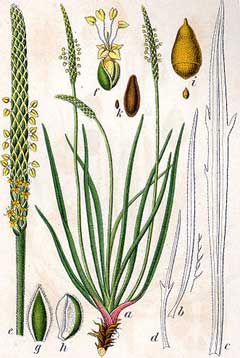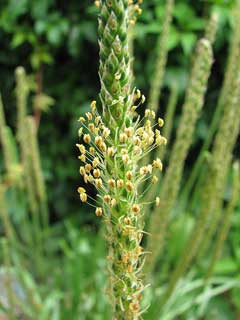 |
|
http://commons.wikimedia.org/wiki/File:Plantago_maritima_Sturm63.jpg |
 |
| http://commons.wikimedia.org/wiki/User:Nova |
Translate this page:
Summary
Physical Characteristics

 Plantago maritima is a PERENNIAL growing to 0.2 m (0ft 8in) by 0.2 m (0ft 8in).
Plantago maritima is a PERENNIAL growing to 0.2 m (0ft 8in) by 0.2 m (0ft 8in).
See above for USDA hardiness. It is hardy to UK zone 6 and is not frost tender. It is in flower from June to August, and the seeds ripen from August to September. The species is hermaphrodite (has both male and female organs) and is pollinated by Wind. The plant is self-fertile.
It is noted for attracting wildlife.
Suitable for: light (sandy), medium (loamy) and heavy (clay) soils and prefers well-drained soil. Suitable pH: mildly acid, neutral and basic (mildly alkaline) soils and can grow in saline soils.
It cannot grow in the shade. It prefers moist soil. The plant can tolerate maritime exposure.
UK Hardiness Map
US Hardiness Map
Synonyms
Plant Habitats
Cultivated Beds;
Edible Uses
Edible Parts: Leaves Seed
Edible Uses:
Young leaves - raw or cooked[2, 61, 105, 183]. A delicious flavour[172]. This is one of the nicer-tasting members of the genus, the leaves are fairly low in fibres and make an acceptable addition to a mixed salad[K]. The leaves are canned for winter use in Alaska[183]. Seed - raw or cooked. The seed can be ground into a powder and used as a flour extender[172]. The seed is very small and tedious to harvest[172].
References More on Edible Uses
Medicinal Uses
Plants For A Future can not take any responsibility for any adverse effects from the use of plants. Always seek advice from a professional before using a plant medicinally.
Laxative
Plantain seeds contain up to 30% mucilage which swells up in the gut, acting as a bulk laxative and soothing irritated membranes[238]. Sometimes the seed husks are used without the seeds[238].
References More on Medicinal Uses
The Bookshop: Edible Plant Books
Our Latest books on Perennial Plants For Food Forests and Permaculture Gardens in paperback or digital formats.

Edible Tropical Plants
Food Forest Plants for Hotter Conditions: 250+ Plants For Tropical Food Forests & Permaculture Gardens.
More

Edible Temperate Plants
Plants for Your Food Forest: 500 Plants for Temperate Food Forests & Permaculture Gardens.
More

More Books
PFAF have eight books available in paperback and digital formats. Browse the shop for more information.
Shop Now
Other Uses
References More on Other Uses
Cultivation details
Succeeds in any moderately fertile soil in a sunny position[200].
References Carbon Farming Information and Carbon Sequestration Information
Temperature Converter
Type a value in the Celsius field to convert the value to Fahrenheit:
Fahrenheit:
The PFAF Bookshop
Plants For A Future have a number of books available in paperback and digital form. Book titles include Edible Plants, Edible Perennials, Edible Trees,Edible Shrubs, Woodland Gardening, and Temperate Food Forest Plants. Our new book is Food Forest Plants For Hotter Conditions (Tropical and Sub-Tropical).
Shop Now
Plant Propagation
Seed - sow spring in a cold frame. When they are large enough to handle, prick the seedlings out into individual pots and plant them out in early summer. A sowing can be made outdoors in situ in mid to late spring if you have enough seeds.
Other Names
If available other names are mentioned here
Native Range
TEMPERATE ASIA: Afghanistan, Iran, Lebanon, Syria (west), Turkey, Armenia, Russian Federation (Buryatia, Tyva, Respublika, Chita, Irkutsk, Omsk, Tyumen), Kazakhstan, Kyrgyzstan, Turkmenistan, Mongolia NORTHERN AMERICA: Canada (Northwest Territories, Yukon), Québec, Nova Scotia, Ontario (north), Prince Edward Island, New Brunswick, Newfoundland and Labrador, Alberta, Manitoba (northeast), British Columbia (west)), Greenland, United States (Alaska, Connecticut (south), Maine (south), Massachusetts (east), New Hampshire (southeast), New Jersey, New York (southeast), Rhode Island, Oregon (west), Washington (west), California) SOUTHERN AMERICA: Argentina (Chubut, Mendoza, Neuquén, Río Negro, Santa Cruz, Tierra del Fuego), Chile EUROPE: Denmark, Finland, Faroe Islands, United Kingdom, Ireland, Iceland, Norway, Sweden, Austria, Belgium, Switzerland, Czech Republic, Germany, Hungary, Netherlands, Poland, Slovakia, Russian Federation (European part), Belarus, Estonia, Lithuania, Latvia, Moldova, Ukraine (incl. Krym), Albania, Croatia, Italy, Romania, Serbia, Spain, France, Portugal AFRICA: Algeria, Morocco
Weed Potential
Right plant wrong place. We are currently updating this section.
Please note that a plant may be invasive in one area but may not in your area so it's worth checking.
Conservation Status
IUCN Red List of Threatened Plants Status :

Growth: S = slow M = medium F = fast. Soil: L = light (sandy) M = medium H = heavy (clay). pH: A = acid N = neutral B = basic (alkaline). Shade: F = full shade S = semi-shade N = no shade. Moisture: D = dry M = Moist We = wet Wa = water.
Now available:
Food Forest Plants for Mediterranean Conditions
350+ Perennial Plants For Mediterranean and Drier Food Forests and Permaculture Gardens.
[Paperback and eBook]
This is the third in Plants For A Future's series of plant guides for food forests tailored to
specific climate zones. Following volumes on temperate and tropical ecosystems, this book focuses
on species suited to Mediterranean conditions—regions with hot, dry summers and cool, wet winters,
often facing the added challenge of climate change.
Read More
Expert comment
Author
L.
Botanical References
17
Links / References
For a list of references used on this page please go here
Readers comment
© 2010, Plants For A Future. Plants For A Future is a charitable company limited by guarantee, registered in England and Wales. Charity No. 1057719, Company No. 3204567.